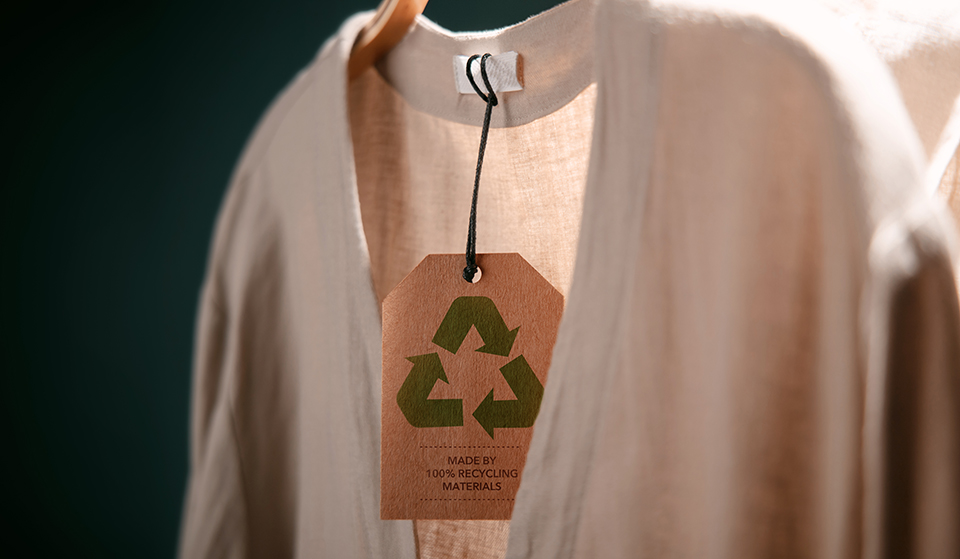France could soon pass a decree requiring every item of clothing sold in the country to carry a label detailing its exact impact on the climate.
The European Union is considering a similar rule for the rest of its members.

If extreme weather events like the Uttarakhand cloudburst are a result of West-induced climate change, is it morally right for consumers in the West to expect eco-labels for garments and textiles produced in Asia? Climate change is primarily the result of urbanization and industrialization. For that reason, expecting producers in countries such as India, Bangladesh, and China to adopt environment-friendly practices smacks the white man’s burden in an age when globalization has changed the rules, even the game, of trade across boundaries.
The desire for eco-labels may have originated as a call of conscience but has turned out to be misguided. In the last four decades, garment production has shifted to the developing world while consumption is overwhelmingly in the West.
With the end of import quotas in 2005 and the removal of tariff barriers, trade in textiles and clothing became freer. Countries such as India, keen on export-led growth, were able to earn significant foreign exchange from this sector. Countries like Norway which, in the 1970s, bought garments mostly from neighboring countries, today import most of their needs from Asia at lower prices.
This growth has had an environmental cost — and the West is protesting too loudly about this as if it has not benefited from cheaper imports. The textile industry is castigated as a major greenhouse gas emitter owing to its size and scope, and it is said apparels and textiles account for approximately 10 percent of the total carbon impact.
As these facts became known, environment-conscious consumers were ready to pay for keeping the planet green for the next generation.
Before we move further, let us first understand the definition of a sustainable fashion item which is extremely arbitrary. What one might consider sustainable can go completely against the vision of someone else. Furthermore, sustainability is such a wide topic. It should be looked at from many different perspectives at the same time. For example, how much CO2 emissions are involved in the production of a garment, how many liters of water, etc. All this is affected by what a product is made from – organic cotton or recycled fibers, etc how a garment is made, and lastly how far a product has to travel and by what means before it reaches the consumer.
But what is carbon labeling exactly? Could it help the fashion industry to become more sustainable? And most important can carbon labels also become “Fashionable”?

Carbon labeling for the fashion industry is a very recent concept, at least in my 30-odd years in the industry have never heard of it. And I am sure most of you also must have not heard about it.
So let us start from scratch and understand what it is first.
A carbon emissions label displays the CO2 emissions created as a by-product of manufacturing, transporting, and disposing of a particular product. It is often expressed in kilograms of CO2.
While this figure is still difficult to put into context for most of us, it offers a quick indication of the ecological footprint of an item. Soon, this piece of information could become the standard for anyone wishing to minimize her or his ecological footprint, and let us be honest; this should be everyone’s concern because every item we purchase leaves a mark on our planet, a footprint. It is easy to understand that through the data carbon labels bring to the table, we would be able to make better-informed decisions about our footprint.
Being in the trade, we know for sure that the amount of clothes bought in the EU per person has increased by 40 % in just a few decades, driven by a fall in prices and the increased speed with which fashion is delivered to consumers.
Clothing accounts for between 2 % and 10 % of the environmental impact of EU consumption. This impact is often felt in third countries, as most production takes place abroad. The production of raw materials, spinning them into fibers, weaving fabrics, and dyeing require enormous amounts of water and chemicals, including pesticides for growing raw materials such as cotton.
Consumer use also has a large environmental footprint due to the water, energy, and chemicals used in washing, tumble drying, and ironing, as well as microplastics, shed into the environment. Less than half of used clothes are collected for reuse or recycling when they are no longer needed, and only 1 % are recycled into new clothes since technologies that would enable recycling clothes into virgin fibers are only starting to emerge. Various ways to address these issues have been proposed, including developing new business models for clothing rental, designing products in a way that would make re-use and recycling easier (circular fashion), convincing consumers to buy fewer clothes of better quality (slow fashion), and generally steering consumer behavior towards choosing more sustainable options.

“Knowledge is power”. Would carbon labels bring power to consumers? Knowing the carbon emissions of their products should help brands reduce their impact in the first place, but it could also shift the demand towards items with a smaller ecological footprint. And it has been proven to be true for the food industry.
We have seen with every new wave of a sustainability initiative in fashion, there is always the other side of the coin: Green Washing.
To fight greenwashing, transparency is key. And even though transparency is at the core of carbon labels, they surely can be used for greenwashing purposes. For instance, a fast fashion brand could create “carbon neutral” clothes simply by purchasing offsets to balance out very wasteful production.
This does not reduce their footprint; it only makes them pay to continue their “business as usual” operations while purchasing offsets whose legitimacy is often questionable.
From recycled materials and organic yarns to fair wages for workers, fashion is full of claims about ways in which it can mitigate its impact on the planet. Historically, however, most brands’ promises have been voluntary and their progress self-reported. In other words, largely unchecked and unlikely to face punishment if or when they fall short of targets.
But change is in the air!
Governments and legislators appear to be waking up to the fact that companies are not reforming themselves at a pace and scale that will meaningfully combat climate change.
If passed, many of the bills could change what we — the consumer — see on our clothing labels or even the design of what we find on store shelves. The movement also reflects a shift away from the idea that the burden should rest primarily on shoppers to buy better and buy less.
It has to be noted that the consumers are not, cannot, and should not be the driving force for completely changing an industry — not least because as long as it is easy, fast, and cheap to buy fashion, then the sustainability aspect of the offer will always be a secondary choice.
Any changes driven by regulation will be felt across the industry, not only in the West but also in the global powerhouse of fashion production: Asia. Many proposals could have a deep impact there, leading to improved labor standards and pollution levels but also higher costs associated with new paperwork and switches to certified materials demanded by laws.
RELATED TOPICS:#NA
Leave a comment
Our email address will not be published. Required fields are marked *







4 Comments
Http://Corkforest.com/__media__/js/netsoltrademark.php?d=saviers.com/__media__/js/netsoltrademark.php?d=stevesmolds.com%2F__media__%2Fjs%2Fnetsoltrademark.php%3Fd%3Ddruckermail.com%252F__media__%252Fjs%252Fnetsoltrademark.php%253Fd%253DWww.Century-Square.Apr 26, 2024 at 03:59 am
Hiya very cool web site!! Guy .. Beautiful .. Wonderful .. I'll bookmark your site and take the feeds additionally? I'm glad to search out so many helpful info here within the post, we want work out more strategies in this regard, thank you for sharing. . . . . .
Pg333Feb 29, 2024 at 06:01 am
I have read so many articles on the topic of the blogger lovers except this article is actually a fastidious article, keep it up.
Aarti SoodDec 07, 2022 at 12:05 pm
Eye opener...and also makes one aware of d lurking crisis..However all I can say is tat we all should put in our bit...for environmental safety...Very well researched and thought provoking article..
Anurag SDec 05, 2022 at 19:37 pm
While I agree with the article, there are no easy solutions. Climate is a clear and present danger now - it wasn't when the west was developing. If China, India etc are allowed to follow the same development trajectory as the West, we may not have a world any longer. Nor can we, in all fairness, cap the development in the global South. So what can be done? IMHO, the global South also needs to control its climate impact. But this would need money, which needs to be funded by the West - they need to think of it as reparations for their depradations of the past. Not an easy discussion either way………..